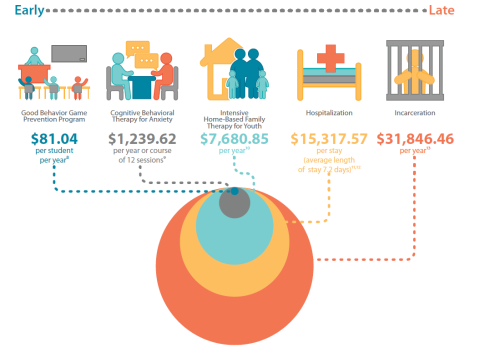Behavioral Health & Justice - Challenge Your Assumptions, Uncover Your Opportunity
Upcoming Events
Related News
From Our Partners
This post is sponsored by our partners at KPMG.
Now, more than ever, counties need to address the mental health epidemic facing 1 in 5 adults in the United States. Although counties annually invest over $83 billion in their local health systems, less than half of those that require treatment actually receive it (NACo).
Unmet demand for care comes at a cost that escalates in volume and complexity the longer it is left unaddressed. For example, counties that make early investments in classroom-based behavioral health programs spend approximately $81.04 per student annually. This represents a fraction of the investment required for cognitive behavioural therapy, and even less compared to costs associated with the adverse outcomes of mental illness, such as hospital stays and incarceration (see figure below) (MHA).

The call to action is clear, but the resources available to counties are often constrained and uncertain. The disparities found in mental health and addictions care are impacted by funding, facilities and providers— leaving counties in the age-old predicament of “doing more with less”.
To overcome this challenge, KPMG focuses on bringing the locus of control back into the hands of the counties— starting by looking internally for ways to improve access, quality and equitable distribution of care with existing resources. For example, KPMG worked with Riverside County to increase their capacity for delivering behavioral health services without hiring additional staff. Access to care was improved by providing 200,000 hours of additional annual outpatient services, allowing the County to service an additional 1,300 unique patients per week.
The following questions provide initial talking points for counties to investigate opportunities on improving their value for investment in behavioural health:
- Population-Based Resourcing: How does your department collect and use data to plan and allocate resources (i.e. human, financial, and physical— such as facilities) against consumer needs?
For example, KPMG supported the review and adjustment of clinic operations and program designs to match the needs of Riverside County residents. This was important to ensure that consumers receive the right type of care in the right setting. As part of this realignment, the department reviewed and confirmed the roles, responsibilities, skillsets, and standards for every outpatient staff member to more efficiently and effectively serve their consumers. This helped outpatient staff provide 4,000 additional weekly services and increased the frequency of services such as individual therapy by 85% per staff member. - Performance Management: Does your organization have clear visibility into staff performance and is this data routinely reviewed and acted upon at the appropriate levels?
For example, KPMG developed a performance reporting tool that displayed key metrics for each layer of the organization – from leadership to program staff. Weekly program performance reviews helped to optimize the use of staff while operational and financial analysis for department leaders helped allocate resources and determine organizational priorities. Overall staff direct service time increased by 35% while unaccounted for time was nearly eliminated. This tool and embedded process will continue to assist department and county leadership in achieving the desired outcomes for consumers while maintaining financial sustainability. - Data for Decision-Making: Is your department using data and creative problem solving to develop tools and strategies for improved efficiency and effectiveness?
For example, reviewing performance and productivity data at regular intervals enabled data-driven decision making in the areas of personnel management, clinic processes, and service design. The reporting tool also provided an improved understanding of consumer demand trends which guides the connection of consumers to the most appropriate care setting (e.g. Full Service Partnerships, outpatient clinics, FQHCs). Reviewing and acting on this data helps to realize the complementary goals of providing the highest quality of care to consumers while using county resources in the most efficient and economical manner.
For Department leaders, the performance reporting tool was used to reallocate staff based on clinic consumer demand and workforce supply. This provides decision making support for evaluating staffing requests by reviewing improved and sustained productivity rates, higher demands and service to the targeted client population.
KPMG also developed an innovative scheduling model that ran thousands of simulations to determine the most effective schedule for every psychiatrist in Riverside County. This tool helped to increase psychiatrist productivity by 30% and increase patient throughput across the county’s 45 outpatient and full service-partnership programs by mitigating the impact of no-shows on staff productivity.
Post Sponsor




















